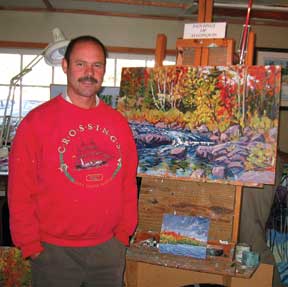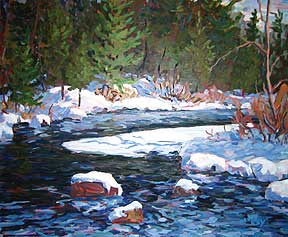|
 The
Natural World through the eyes of artist David Kay The
Natural World through the eyes of artist David Kay
by Liz Clark
Like a ribbon of rainbow, the drive across
Highway 60 west of Whitney to Huntsville offers a beautiful
glimpse of Algonquin Provincial Park, a 7,725 square kilometre
wonderland of native forest and crystal-clear waterways. From
his home in the Village of Whitney, artist David Kay captures
photographic images of wildlife and paints the natural world
in Algonquin that few of us could ever hope to see.
In wintertime David snowshoes up icy creeks,
rivers, and across lakes, hoping to literally stumble across
a special spot to paint. When breakup comes, he’ll canoe
in, or ride over rough trails on his mountain bike. At times
he’ll bushwhack to a new location found on his topographical
map.
“I’ll pick a place on the map
I’ve not been to before and hike to the spot. If I’m
moved by it, I’ll begin painting directly, mostly out
of an emotional response to what I’m seeing,” David
says. He explains the importance of quickly capturing the
light before it changes. “Then back at the studio I’ll
review the composition from an intellectual point of view.”
A beautiful winter landscape, on display
at the Algonquin Park Visitor Centre last October during the
East Central Ontario Art Association’s Annual Exhibition,
exemplifies this emotion.
 “I
named the painting ‘Algonquin Waters’ for one of
many rivers originating in Algonquin’s highlands that
eventually finds its way through the bush, over the Canadian
Shield, and down into the St. Lawrence River en route to the
Atlantic.” “I
named the painting ‘Algonquin Waters’ for one of
many rivers originating in Algonquin’s highlands that
eventually finds its way through the bush, over the Canadian
Shield, and down into the St. Lawrence River en route to the
Atlantic.”
Bordered on one side by vertical lines
of a still-bare deciduous tree, the scene is softened on the
other by the textural quality of evergreen boughs. Warming
rays of sunshine begin to melt the icy river and its course
quickens between the snow-crested rocky shores. In the middle
ground, light and shadow contrasts play across the bend in
the river adding depth and illumination to this focal point.
And in the foreground, the play of light and shadow across
snow-capped river rocks creates a dynamic three-dimensional
effect. Well deserved, “Algonquin Waters” took the
red ribbon as “Best of Show.”
Now in his mid-forties, David takes time
to reflect on his past. As a child in Picton then in Newmarket,
Ontario, he remembers a time of daydreaming in school like
many other boys.
“My mind was off in a space, filled
with line and colour, shapes and forms that found their way
onto sheets of paper of all sorts,” David says and admits
the compulsion to collect natural objects and create was far
stronger than his interest in academic subjects at the time.
In a 1937 article entitled “The Sculptor
Speaks,” noted sculptor Henry Moore’s response to
form-interest reassured David of his own fascination with
the shapes of stones, skulls and bones: “There are universal
shapes to which everybody is subconsciously conditioned and
to which they can respond if their conscious control does
not shut them off…natural forms, such as bones, shells,
and pebbles, etc.”
David studied close to home at the former
Schneider School of Fine Art in Actinolite, Ontario, then
farther afield at the famed Instituto d’Allende in San
Miguel, Mexico. The brilliant colours, rich culture, and pungent
aromas of highly spiced foods sparked alight a more emotive
element in his painting.
“But I love painting around Algonquin
Park,” David says. “Here the natural shape of the
landscape is unaltered by human hands.”
Whitney has been David’s home for
the past sixteen years. The Kay family bought the Algonquin
East Gate Motel and the artist established the David Kay Art
Gallery and Studio alongside the motel. Although David says
the village may seem somewhat isolated, its location at the
eastern access to the Algonquin Provincial Park draws people
to the region from all corners of the world.
“This motel business is not nine-to-five,
so it has worked quite well for me,” David explains.
“But when my father died seven years ago, it was a great
loss.”
Although Mary Kay is in retirement now,
David’s mother often sits on the verandah on a sunny
afternoon, welcoming visitors to the motel and gallery. Friend
Morris Cameron, who helps David run the motel during busy
times, is a great booster of David’s work as well, encouraging
visitors to leaf through the wildlife photo albums in the
breakfast room and if they have time, to tour the gallery
and studio.
David and his wife, Diane, make time to
travel and enjoy visiting places where the culture, language
and religion is different from their own.
“Even in such places as Borneo, Thailand,
Myanmar, and most recently cruising among Indonesia’s
Komodo Islands, Diane always manages to find an English language
book to read on location while I paint direct with watercolours
for an hour or two—just about the same time I take with
oils back home.”
And back home in Whitney, David’s
brightly lit one-room studio and gallery is a welcoming place.
Wood smoke, turpentine and the rich, aromatic scent of oils
once confined in colourful tubes seems to have seeped into
every nook and cranny.
Various sizes of framed woodland images
hang on the walls and rest against table-top easels. A triptych
in progress of Whitney, with a well-known old-timer in one
scene, stands stacked with many more paintings along the walls
on the floor. “Madawaska River,” a 24” x 36”
work-in-progress, stands on a large floor easel in the centre
of the room.
While two-dimensional oils on masonite
board predominate, a three-dimensional piece called, “Colour
Covering”—a mixture of expelled paint tubes in riotous
colours, a couple of frazzled paint brushes, a few long shafts
of horse hair and small paint-spattered boards set askew—is
taking on a life of its own on a table top. A clipping from
a newspaper, “Brushes with adventure,” looks like
the next item to find a home in this creative, three-D work-in-progress.
“Colour has always been important
to me,” David says as he looks out his window on a winter’s
morning. “It looks drab now, but when you really look,
there are some interesting colours. When you have one colour
beside another it looks different somehow, like the use of
complementary colours (orange and blue, yellow and violet,
red and green) as opposed to two colours that are similar.
Then as the light changes you see just a hint of a vivid hue
that punches right out at you. Sometimes I ask myself ‘why
did I stop to consider this view.’ Very often that little
splash of colour is the reason.”
It has been said that David’s paintings
reflect the ruggedness and freedom of the environment as he
perceives it. Whenever a bog, a river or a creek within a
secluded corner of this vast northern forest captures David’s
imagination, he’ll begin again to paint another inspiring
interpretation of the natural world.
David Kay Art Gallery and Studio
P. O. Box 193, Whitney ON K0J 2M0
Phone: 613-637-2652
This is an original story,
first published in The Country Connection Magazine,
Issue 50, Summer 2005. Copyright Liz Clark.
RETURN
TO STORY INDEX
RETURN
TO BACK ISSUE PAGE
|

